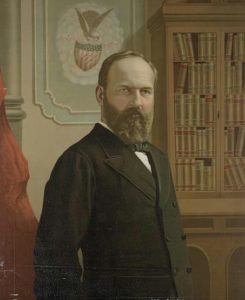We admit it – we’ve already got a touch of spring fever and it’s not even February yet. Oh well, what’s the harm, right? Well, in our line of work, once thoughts of spring come to mind, so do thoughts of air conditioning. And then it hit us: wouldn’t it be a refreshing change of pace to write a blog about how air conditioning came to be?! We thought so, and had fun researching the topic and being reminded of material included long ago in our state licensing classes.
The Early Years
The first known attempt at building an air conditioner was made by Dr. John Gorrie (1803-1855), an American physician, in Apalachicola, Florida. During his practice there in the 1830’s, Dr. Gorrie created an ice-making machine that basically blew air over a bucket of ice for cooling hospital rooms of patients suffering from malaria and yellow fever.

President James Garfield
In 1881, when President James Garfield was dying, naval engineers constructed a box-like structure containing cloths saturated with melted ice water, where a fan blew hot air overhead. This contraption could lower a room’s temperature by 20 degrees, but consumed half a million pounds of ice in just two months.
An American engineer, Willis Carrier, first made a close approximation to the modern air conditioner in 1902. The machine at that time was called “Apparatus for Treating Air” and was built for the Sackett-Wilhelms Lithographing and Publishing Co. in Brooklyn, New York. Chilled coils were used in the machine to cool air and lower humidity to fifty-five percent.
Air Conditioning for the Masses
The general public’s first encounter with mechanical cooling took place in American movie theaters. The Follies Bergere Theater in New York City installed the first air-conditioning system in a theater in 1911, followed shortly thereafter by the New Empire Theater in Montgomery, Alabama and the Central Park Theater in Chicago.
In the 1920’s and 30’s, ground-breaking experiments with mechanical cooling turned public attendance at movies, plays, and concerts into a summertime ritual. Air conditioning itself became an attraction, as people flocked to movie theaters to experience the new way to stay cool on those hot summer days.
Air Conditioning in the Home
Not until after World War II did air conditioning enter the homes of average American families. Engineered air was marketed to the public as an essential component of modern living. Manufacturers claimed that it promoted better sleeping and eating, healthier air quality, cleaner interiors free from pollen and dust, and the enjoyment of nature through glass window walls without the discomforts of summer heat and humidity. With its steadily decreasing costs, air conditioning was advertised as a technology “for the millions, not just for millionaires.”

The refrigerator provided the model for early residential air conditioners. As consumer interest grew in the late 1920’s, refrigerator manufacturers were among the first to develop air conditioners due to their technical expertise with small-scale refrigeration units, automatic controls as well as mass-production.
The widespread adoption of air conditioner’s in the mid-20th century predicted the demise of front porches, wide eaves, and high ceilings. It also fueled the explosive postwar growth of Sunbelt cities like Houston, Phoenix, Las Vegas, and Miami, where it was once not practical to live because of the long hot summers. Air conditioning launched new forms of architecture and altered the ways Americans live, work, and play.
Domestic air conditioning meant that traditional architectural features–wide eaves, deep porches, thick walls, high ceilings, attics, and cross ventilation–were no longer needed to promote natural cooling. All of us who have experienced the cooling benefits of central air conditioning in times of searing heat waves know just how difficult life would be without it.
Today, according to the U.S. Department of Energy, “three-quarters of all homes in the United States have air conditioners. Air conditioners use about 6% of all the electricity produced in the United States, at an annual cost of about $29 billion to homeowners.”
That’s it for now from Optimum Air, your DFW area home heating and cooling resource for all seasons.